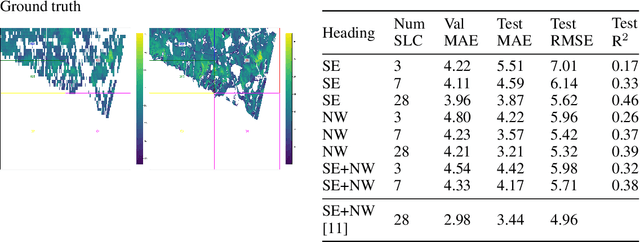Karol Bot
Tomographic SAR Reconstruction for Forest Height Estimation
Dec 03, 2024



Abstract:Tree height estimation serves as an important proxy for biomass estimation in ecological and forestry applications. While traditional methods such as photogrammetry and Light Detection and Ranging (LiDAR) offer accurate height measurements, their application on a global scale is often cost-prohibitive and logistically challenging. In contrast, remote sensing techniques, particularly 3D tomographic reconstruction from Synthetic Aperture Radar (SAR) imagery, provide a scalable solution for global height estimation. SAR images have been used in earth observation contexts due to their ability to work in all weathers, unobscured by clouds. In this study, we use deep learning to estimate forest canopy height directly from 2D Single Look Complex (SLC) images, a derivative of SAR. Our method attempts to bypass traditional tomographic signal processing, potentially reducing latency from SAR capture to end product. We also quantify the impact of varying numbers of SLC images on height estimation accuracy, aiming to inform future satellite operations and optimize data collection strategies. Compared to full tomographic processing combined with deep learning, our minimal method (partial processing + deep learning) falls short, with an error 16-21\% higher, highlighting the continuing relevance of geometric signal processing.
3D-SAR Tomography and Machine Learning for High-Resolution Tree Height Estimation
Sep 09, 2024Abstract:Accurately estimating forest biomass is crucial for global carbon cycle modelling and climate change mitigation. Tree height, a key factor in biomass calculations, can be measured using Synthetic Aperture Radar (SAR) technology. This study applies machine learning to extract forest height data from two SAR products: Single Look Complex (SLC) images and tomographic cubes, in preparation for the ESA Biomass Satellite mission. We use the TomoSense dataset, containing SAR and LiDAR data from Germany's Eifel National Park, to develop and evaluate height estimation models. Our approach includes classical methods, deep learning with a 3D U-Net, and Bayesian-optimized techniques. By testing various SAR frequencies and polarimetries, we establish a baseline for future height and biomass modelling. Best-performing models predict forest height to be within 2.82m mean absolute error for canopies around 30m, advancing our ability to measure global carbon stocks and support climate action.
Unsupervised Wildfire Change Detection based on Contrastive Learning
Nov 26, 2022



Abstract:The accurate characterization of the severity of the wildfire event strongly contributes to the characterization of the fuel conditions in fire-prone areas, and provides valuable information for disaster response. The aim of this study is to develop an autonomous system built on top of high-resolution multispectral satellite imagery, with an advanced deep learning method for detecting burned area change. This work proposes an initial exploration of using an unsupervised model for feature extraction in wildfire scenarios. It is based on the contrastive learning technique SimCLR, which is trained to minimize the cosine distance between augmentations of images. The distance between encoded images can also be used for change detection. We propose changes to this method that allows it to be used for unsupervised burned area detection and following downstream tasks. We show that our proposed method outperforms the tested baseline approaches.
 Add to Chrome
Add to Chrome Add to Firefox
Add to Firefox Add to Edge
Add to Edge